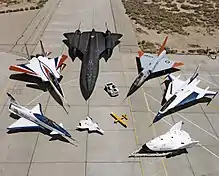List of military aircraft of the United States
This list of military aircraft of the United States includes prototype, pre-production, and operational types. For aircraft in service, see the list of active United States military aircraft. Prototypes are normally prefixed with "X" and are often unnamed (note that these are not the same as the experimental X-planes, which are not generally expected to go into production), while pre-production models are usually prefixed with "Y".
| United States military aircraft |
|---|
|
The United States military currently employs a designation and naming system to provide identifications to all aircraft types. Until 1962, the United States Army, United States Air Force (formerly Army Air Force), and United States Navy all maintained separate systems. In September 1962,[1] these were unified into a single system heavily reflecting the Air Force method. For more complete information on the workings of this system, refer to United States military aircraft designation systems.
This list does not include early aircraft used by the U.S. military during time periods when no numerical designation system was in effect, nor aircraft that did not receive designations for other reasons, such as foreign military aircraft borrowed for testing or civil aircraft impressed into military service during wartime. For these aircraft, see List of undesignated military aircraft of the United States. It also does not include aircraft designated under pre-1962 United States Navy designation systems. For these aircraft, see List of United States Navy aircraft designations (pre-1962).
Prior to 1919
Prior to 1919, all aircraft flown by the Army Air Service were referred to by the designation given to them by their manufacturer. The United States Navy used two designation systems in this time period, but abandoned the second system in 1917 with the country's entry into World War I (WWI). During this period, a variety of both domestic and foreign types were operated, with the latter being the primary front-line types during WWI.
Army Air Service system (1919–1924)
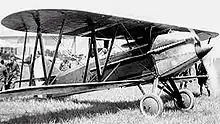
In September 1919, the Army Air Service decided that it needed an organized designation sequence, and adopted fifteen classifications, designated by Roman numerals. Several other unnumbered designations were added later. Each designation was assigned an abbreviation, and each design a number within that abbreviation. Variants were designated by alphabetically appending letters to the design number. For more information on the designation system, see 1919 United States Army Air Service aircraft designation system.
Type O: Foreign-Built Pursuit Aircraft
- Fokker D.VII – Fokker
- Fokker D.VIII – Fokker
Type I: Pursuit, water-cooled
Type II: Pursuit, night
- PN-1 – Curtiss
Type III: Pursuit, air-cooled
- PA-1 – Loening
Type IV: Pursuit, ground attack, 1922
Type V: Two-seat pursuit
- TP-1 – Engineering Division
Type VII: Infantry liaison
- IL-1 – Orenco
Type X: Corps observation
Type XI: Day bombardment
- DB-1 – Gallaudet
Type XII: Night bombardment, short range
- NBS-1 – Martin
- NBS-2 – Lowe-Willard-Fowler
- NBS-3 – Elias
- NBS-4 – Curtiss
Type XIV: Trainer, air-cooled
- TA-1 – Elias
- TA-2 – Huff-Daland
- TA-3 – Dayton-Wright Aircraft
- TA-4 – Engineering Division
- TA-5 – Dayton-Wright Aircraft
- TA-6 – Huff-Daland
Type XV: Trainer, water-cooled
Pursuit, special
- PS-1 – Dayton-Wright
Racer
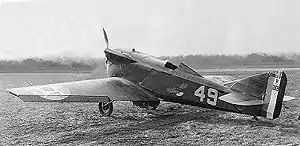
Seaplane
- S-1 – Loening
Transport
- T-1 – Martin
- T-2 – Fokker
- T-3 – Lowe-Willard-Fowler
Lighter-than-air craft
- AC-1 — designed for "long flights and cross-country work", this was a 169 foot long, 180,000 cubic foot buoyancy craft which had one of its earliest long flights in May 1923.[2]
- RN-1 — designated "Zodiac", this was a semi-rigid dirigible, 262.5 feet long with a 360,000 cubic foot buoyancy volume.[3]
Army Air Corps/Army Air Forces/Air Force system (1924–1962)
For more information on the designation systems, see 1924 United States Army Air Service aircraft designation system, 1922 United States Navy aircraft designation system, and List of United States Navy aircraft designations (pre-1962).
OA: Observation Amphibian (1925–1948)
- OA-1 – Loening
- OA-2 – Loening
- OA-3 Dolphin – Douglas
- OA-4 Dolphin – Douglas
- OA-5 – Douglas
- OA-6 – Consolidated
- OA-7 – Douglas
- OA-8 – Sikorsky
- OA-9 Goose – Grumman (redesignated A-9 in 1948)
- OA-10 Catalina – Consolidated (redesignated A-10 in 1948)
- OA-11 – Sikorsky
- OA-12 Duck – Grumman (redesignated A-12 in 1948)
- OA-13 Goose – Grumman
- OA-14 Widgeon – Grumman
- OA-15 Seabee – Republic
- OA-16 Albatross – Grumman (redesignated A-16 in 1948)
A: Amphibian (1948–1962)
- A-9 Goose – Grumman (redesignated from OA-9)
- A-10 Catalina – Consolidated (redesignated from OA-10)
- A-12 Duck – Grumman (redesignated from OA-12)
- A-16 Albatross – Grumman (redesignated from OA-16)
Attack
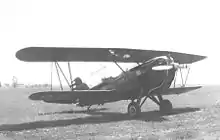
A: Attack (1924–1948)
- A-1 – skipped to avoid confusion with the Cox-Klemin XA-1
- A-2 – Douglas
- A-3 Falcon – Curtiss
- A-4 Falcon – Curtiss
- A-5 Falcon – Curtiss
- A-6 Falcon – Curtiss
- A-7 – Fokker-America
- A-8 – Curtiss
- A-9 – Lockheed
- A-10 Shrike – Curtiss
- A-11 – Consolidated
- A-12 Shrike – Curtiss
- A-13 – Northrop
- A-14 – Curtiss
- A-15 – Martin
- A-16 – Northrop
- A-17 Nomad – Northrop
- A-18 Shrike – Curtiss
- A-19 – Vultee
- A-20 Havoc – Douglas
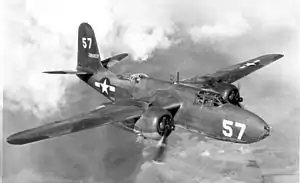 A-20 Havoc
A-20 Havoc - A-21 – Stearman
- A-22 – Martin
- A-23 Baltimore – Martin
- A-24 Banshee – Douglas
- A-25 Shrike – Curtiss
- A-26 Invader – Douglas
- A-27 – North American
- A-28 Hudson – Lockheed
- A-29 Hudson – Lockheed
- A-30 – Martin
- A-31 Vengeance – Vultee
- A-32 – Brewster
- A-33 – Douglas
- A-34 – Brewster
- A-35 Vengeance – Vultee
- A-36 Apache/Invader – North American
- A-37 – Hughes (unofficial designation created for contract purposes)
- A-38 Grizzly – Beechcraft
- A-39 – Kaiser-Fleetwings
- A-40 – Curtiss
- A-41 – Vultee
- A-42 Mixmaster – Douglas
- A-43 Blackhawk – Curtiss-Wright
- A-44 – Convair
- A-45 – Martin
Bomber
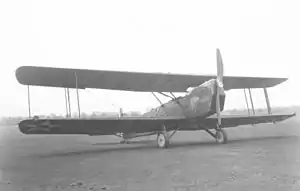
Until 1926, the Army Air Service had three sequences for bombers. Light bombers were indicated by the LB- prefix, medium bombers by the B- prefix, and heavy bombers by the HB- prefix. In 1926, the three-category system was scrapped and all bombers subsequently built were placed in the B- sequence.
LB: Light Bomber (1924–1926)
B: Medium Bomber (1924–1926)
HB: Heavy Bomber (1924–1926)
- HB-1 – Huff-Daland
- HB-2 – Atlantic/Fokker
- HB-3 – Huff-Daland
B: Bomber (1926–1962)
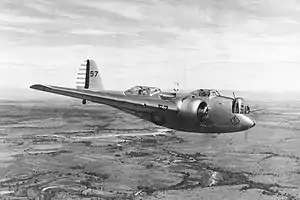
- B-1 – Huff-Daland/Keystone
- B-2 Condor – Curtiss
- B-3 – Keystone
- B-4 – Keystone
- B-5 – Keystone
- B-6 – Keystone
- B-7 – Douglas
- B-8 – Fokker
- B-9 – Boeing
- B-10 – Martin
- B-11 – Douglas
- B-12 – Martin
- B-13 – Martin
- B-14 – Martin
- B-15 – Boeing (redesignated from BLR-1)
- B-16 – Martin
- B-17 Flying Fortress – Boeing
- B-18 Bolo – Douglas
- B-19 – Douglas (redesignated from BLR-2)
- B-20 – Boeing
- B-21 – North American
- B-22 – Douglas
- B-23 Dragon – Douglas
- B-24 Liberator – Consolidated
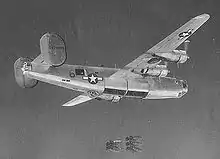 B-24 Liberator
B-24 Liberator - B-25 Mitchell – North American
- B-26 Marauder – Martin
- B-27 – Martin
- B-28 Dragon – North American
- B-29 Superfortress – Boeing
- B-29D Superfortress – Boeing (redesignated B-50)
- B-30 – Lockheed
- B-31 – Douglas
- B-32 Dominator – Consolidated
- B-33 Super Marauder – Martin
- B-34 Lexington – Lockheed
- B-35 – Northrop
- B-36 Peacemaker – Convair
- B-36G Peacemaker – Convair (redesignated B-60)
- B-37 – Lockheed
- B-38 Flying Fortress – Boeing
- B-39 Superfortress – Boeing
- B-40 Flying Fortress – Boeing
- B-41 Liberator – Consolidated
- B-42 Mixmaster – Douglas
- B-43 Jetmaster – Douglas
- B-44 Superfortress – Boeing
- B-45 Tornado – North American
- B-46 – Convair
- B-47 Stratojet – Boeing
- B-47C Stratojet – Boeing (redesignated B-56)
- B-48 – Martin
- B-49 – Northrop
- B-50 Superfortress – Boeing (redesignated from B-29D)
- B-50C Superfortress – Boeing (redesignated B-54)
- B-51 – Martin
- B-52 Stratofortress – Boeing
_in_flight_061127-F-1234S-026.jpg.webp) JB-52E Stratofortress
JB-52E Stratofortress - B-53 – Convair
- B-54 – Boeing (redesignated from B-50C)
- B-55 – Boeing
- B-56 – Boeing (redesignated from B-47C)
- B-57 Canberra – Martin
- B-57D Canberra – Martin
- B-57F Canberra – Martin/General Dynamics
- B-58 Hustler – Convair
- B-59 – Boeing
- B-60 – Convair (redesignated from B-36G)
- B-61 Matador – Martin
- B-62 Snark – Northrop
- B-63 RASCAL – Bell
- B-64 Navaho – North American
- B-65 Atlas – Convair
- B-66 Destroyer – Douglas
- B-67 Crossbow – Radioplane
- B-68 – Martin
- B-68 Titan – Martin (conflicting designation, assigned after the original B-68 was canceled)
- B-69 Neptune – Lockheed
- B-70 Valkyrie – North American
- B-71 Blackbird – Lockheed[4]
Beginning with #69, the "M-" (missile) and "B-" (bomber) series diverged. The missiles designated M-69 to M-92, some of which are incorrectly labeled as "formerly designated B-xx" in some sources, never used a "B-" series designation. Beginning with #70, another sequence diverged, the "RS-" (Reconnaissance/Strike) series, which was later changed to the "SR-" (Strategic Reconnaissance) series of the Tri-Service system.
Non-sequential
Some bomber designations were assigned out of sequence.
- B-20 Havoc – Douglas (redesignated from A-20 in 1948 after original B-20 was canceled)
- B-26 Invader – Douglas (redesignated from A-26 in 1948 after original B-26 was retired)
BLR: Bomber, long range (1935–1936)
A short-lived designation used from 1935–1936 to refer to three long-range bomber projects commissioned by the Army Air Corps. Most of the bombers were night bombers.
C: Cargo (1924–1962)
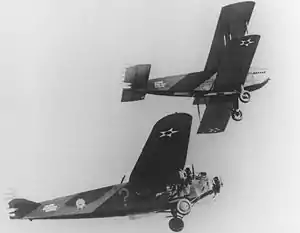
- C-1 – Douglas
- C-2 – Fokker
- C-3 – Ford
- C-4 – Ford
- C-5 – Fokker
- C-6 – Sikorsky
- C-7 – Fokker
- C-8 – Fairchild
- C-9 – Ford
- C-10 Robin – Curtiss-Wright
- C-11 Fleetster – Consolidated
- C-12 Vega – Lockheed
- C-13 – skipped
- C-14 – Fokker
- C-15 – Fokker
- C-16 – Fokker
- C-17 Super Vega – Lockheed
- C-18 Monomail – Boeing
- C-19 Alpha – Northrop
- C-20 – Fokker
- C-21 Dolphin – Douglas
- C-22 Fleetster – Consolidated
- C-23 Altair – Lockheed
- C-24 – Fairchild
- C-25 Altair – Lockheed
- C-26 Dolphin – Douglas
- C-27 Airbus – Bellanca
- C-28 – Sikorsky
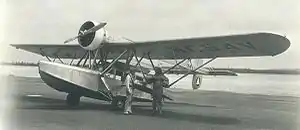 Sikorsky C-28
Sikorsky C-28 - C-29 Dolphin – Douglas
- C-30 Condor – Curtiss-Wright
- C-31 – Kreider-Reisner
- C-32 – Douglas
- C-33 – Douglas
- C-34 – Douglas
- C-35 Electra – Lockheed
- C-36 Electra – Lockheed
- C-37 Electra – Lockheed
- C-38 – Douglas
- C-39 – Douglas
- C-40 Electra – Lockheed
- C-41 – Douglas
- C-41A – Douglas
- C-42 – Douglas
- C-43 Traveller – Beechcraft
- C-44 – Messerschmitt
- C-45 Expeditor – Beechcraft
- C-46 Commando – Curtiss-Wright
- C-47 Skytrain – Douglas
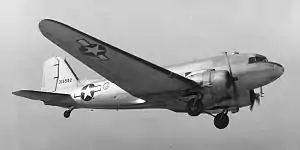 C-47 Skytrain
C-47 Skytrain- C-47F Skytrain – Douglas
- AC-47 Spooky – Douglas
- C-48 Skytrain – Douglas
- C-49 Skytrain – Douglas
- C-50 Skytrain – Douglas
- C-51 Skytrain – Douglas
- C-52 Skytrain – Douglas
- C-53 Skytrooper – Douglas
- C-54 Skymaster – Douglas
- C-55 Commando – Curtiss-Wright
- C-56 Lodestar – Lockheed
- C-57 Lodestar – Lockheed
- C-58 Bolo – Douglas
- C-59 Lodestar – Lockheed
- C-60 Lodestar – Lockheed
- C-61 Forwarder – Fairchild
- C-62 – Waco
- C-63 Hudson – Lockheed
- C-64 Norseman – Noorduyn
- C-65 Skycar – Stout
- C-66 Lodestar – Lockheed
- C-67 Dragon – Douglas
- C-68 – Douglas
- C-69 Constellation – Lockheed
- C-70 Nightingale – Howard
- C-70B Nightingale – Howard
- C-71 Executive – Spartan
- C-72 – Waco
- C-73 – Boeing
- C-74 Globemaster – Douglas
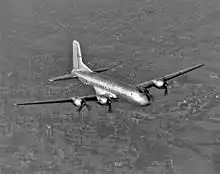 C-74 Globemaster
C-74 Globemaster - C-75 – Boeing
- C-76 Caravan – Curtiss-Wright
- C-77 – Cessna
- C-77B/C/D – Cessna
- C-78 Bobcat – Cessna
- C-79 – Junkers
- C-80 – Harlow
- C-81 Reliant – Stinson
- C-82 Packet – Fairchild
- C-83 Coupe – Piper
- C-84 – Douglas
- C-85 Orion – Lockheed
- C-86 Forwarder – Fairchild
- C-87 Liberator Express – Consolidated
- C-88 – Fairchild
- C-89 – Hamilton
- C-90 – Luscombe
- C-91 – Stinson
- C-92 – Akron-Funk
- C-93 Conestoga – Budd
- C-94 – Cessna
- C-95 Grasshopper – Taylorcraft
- C-96 – Fairchild
- C-97 Stratofreighter – Boeing
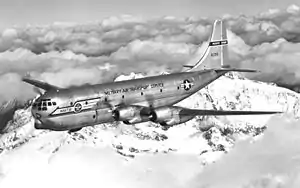 C-97 Stratofreighter
C-97 Stratofreighter- KC-97 Stratofreighter – Boeing
- C-98 Clipper – Boeing
- C-99 – Convair
- C-100 Gamma – Northrop
- C-101 Vega – Lockheed
- C-102 Sportster – Rearwin
- C-103 – Grumman
- C-104 – Lockheed
- C-105 – Boeing
- C-106 Loadmaster – Cessna
- C-107 Skycar – Stout
- C-108 Flying Fortress – Boeing
- C-109 Liberator Express – Consolidated
- C-110 – Douglas
- C-111 Super Electra – Lockheed
- C-112 – Douglas
- C-113 Commando – Curtiss-Wright
- C-114 Skymaster – Douglas
- C-115 Skymaster – Douglas
- C-116 Skymaster – Douglas
- C-117 Super Skytrain – Douglas
- C-117D Super Skytrain – Douglas (redesignated from Navy R4D-8 in 1962)
- C-118 Liftmaster – Douglas
- C-119 Flying Boxcar – Fairchild
- AC-119 – Fairchild
- C-120 Packplane – Fairchild
- C-121 Constellation – Lockheed
- C-121F Constellation – Lockheed
- C-122 Avitruc – Chase
- C-123 Provider – Fairchild
- C-123A – Chase
- C-124 Globemaster II – Douglas
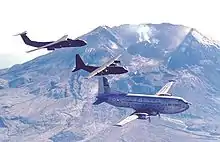 From left to right: C-141, C-130, and C-124 with Mount St. Helens in the background
From left to right: C-141, C-130, and C-124 with Mount St. Helens in the background - C-125 Raider – Northrop
- C-126 – Cessna
- C-127 Beaver – de Havilland Canada (redesignated to L-20)
- C-127 – Douglas (conflicting designation, assigned after original C-127 was redesignated)
- C-128 Flying Boxcar – Fairchild
- C-129 Super Skytrain – Douglas
- C-130 Hercules – Lockheed
- C-130J Super Hercules – Lockheed Martin
- AC-130 – Lockheed
- DC-130 Hercules – Lockheed
- EC-130 – Lockheed
- EC-130H Compass Call – Lockheed
- HC-130 – Lockheed
- KC-130 Hercules – Lockheed
- LC-130 Hercules – Lockheed
- MC-130 – Lockheed
- RC-130 Hercules – Lockheed
- WC-130 Hercules – Lockheed
- C-131 Samaritan – Convair
- C-132 – Douglas
- C-133 Cargomaster – Douglas
- C-134 – Stroukoff
- C-135 Stratolifter – Boeing
- KC-135 Stratotanker – Boeing
- C-136 – Fairchild
- C-137 Stratoliner – Boeing
- C-138 – reserved for Fokker F27, but never assigned
- C-139 – reserved for Lockheed P2V Neptune, but never assigned
- C-140 Jetstar – Lockheed
- C-141 Starlifter – Lockheed
- C-142 – Vought
- C-143 – reserved for what would become the X-19, but never officially assigned and later reused in the Tri-Service system
This sequence was restarted at C-1 with the introduction of the Tri-Service system. However, the original sequence was picked up at C-143 starting in 2005, leading to the US military maintaining two separate sequences for cargo aircraft.
GL: Target Glider (1922–1935)
- GL-1 – McCook Field
- GL-2 – McCook Field
- GL-3 – McCook Field (incorrectly known as "G-3")
A: Aerial Target (1940–1941)
- A-1 – Fleetwings
- A-2 – Radioplane
- A-3 – Curtiss
- A-4 – Douglas
- A-5 – Boeing
- A-6 – Douglas
- A-7 Airacobra – Bell
- A-8 Cadet – Culver (redesignated PQ-8)
PQ: Aerial Target, man carrying (1943–1948)
- PQ-8 Cadet – Culver (redesignated from A-8)
- PQ-9 Cadet – Culver
- PQ-10 – Culver
- PQ-11 – Fletcher
- PQ-12 – Fleetwings
- PQ-13 – ERCO
- PQ-14 Cadet – Culver
- PQ-15 – Culver
OQ: Aerial Target, model airplane (1942–1948)
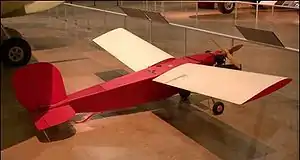
- OQ-1 – skipped
- OQ-2 – Radioplane
- OQ-3 – Radioplane
- OQ-4 – Brunswick-Balke-Collender
- OQ-5 – unknown contractor
- OQ-6 – Radioplane
- OQ-7 – Radioplane
- OQ-8 – skipped
- OQ-9 – skipped
- OQ-10 – skipped
- OQ-11 – Simmonds Aerocessories
- OQ-12 – Radioplane
- OQ-13 – Radioplane
- OQ-14 – Radioplane
- OQ-15 – unknown contractor
- OQ-16 – Frankfort
- OQ-17 – Radioplane
- OQ-18 – unknown contractor
- OQ-19 – Radioplane
BQ: Controllable Bomb (1942–1945)
- BQ-1 – Fleetwings
- BQ-2 – Kaiser-Fleetwings
- BQ-3 – Fairchild
- BQ-4 – Interstate
- BQ-5 – Interstate
- BQ-6 – Interstate
- BQ-7 Flying Fortress – Boeing
- BQ-8 Liberator – Consolidated[5]
CQ: Target Control (1942–1948)
Q: Drone (1948–1962)
- Q-1 – Radioplane
- Q-2 Firebee – Ryan
- Q-3 – Radioplane
- Q-4 – Northrop
- Q-5 Kingfisher – Lockheed
- Q-6 – WADC
- Q-7 – skipped, request for redesignation of QB-17 not approved
- Q-8 Cadet – Culver (redesignated from PQ-8)
- Q-8 – request for redesignation of QF-80 not approved
- Q-9 – WADC
- Q-10 – Radioplane
- Q-11 – WADC
- Q-12 – Beechcraft
- Q-13 – skipped
- Q-14 Cadet – Culver (redesignated from PQ-14)
S: Supersonic/Special Test (1946–1948)
The USAF extablished a separate sequence for purpose-built research aircraft in 1946. Originally designated with the "S" mission letter, the sequence switched to "X" in 1948.
- S-1 – Bell
- S-2 – Bell
- S-3 Stiletto – Douglas
- S-4 Bantam – Northrop
- S-5 – Bell
X: Experimental (1948–1962)
Below is a list of "X-planes" designated before 1962. For a list of X-planes designated after 1962, see #X: Special research.
- X-1 – Bell
- X-2 – Bell
- X-3 Stiletto – Douglas
- X-4 Bantam – Northrop
- X-5 – Bell
- X-6 – Convair
- X-7 – Lockheed
- X-8 – Aerojet
- X-9 Shrike – Bell
- X-10 – North American
- X-11 – Convair
- X-12 – Convair
- X-13 Vertijet – Ryan
- X-14 – Bell
- X-15 – North American
- X-16 – Bell
- X-17 – Lockheed
- X-18 – Hiller
- X-19 – Curtiss-Wright
- X-20 Dyna-Soar – Boeing
P: Pursuit (1924-1948)

Designated P- for "pursuit" until June 1948, nine months after the United States Air Force was founded. After this, all P- designations were changed to F- ("fighter"), but the original numbers were retained.[6]
- P-1 Hawk – Curtiss
- P-2 Hawk – Curtiss
- P-3 Hawk – Curtiss
- P-4 – Boeing
- P-5 Hawk – Curtiss
- P-6 Hawk – Curtiss
- P-7 – Boeing
- P-8 – Boeing
- P-9 – Boeing
- P-10 – Curtiss
- P-11 Hawk – Curtiss
- P-12 – Boeing
- P-13 Viper – Thomas-Morse
- P-14 – Curtiss
- P-15 – Boeing
- P-16 – Berliner-Joyce (redesignated PB-1)
- P-17 Hawk – Curtiss
- P-18 – Curtiss
- P-19 – Curtiss
- P-20 – Curtiss
- P-21 – Curtiss
- P-22 Hawk – Curtiss
- P-23 Hawk – Curtiss
- P-24 – Lockheed
- P-25 – Consolidated
- P-26 Peashooter – Boeing
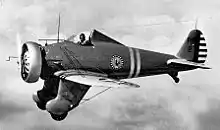 Boeing P-26
Boeing P-26 - P-27 – Consolidated
- P-28 – Consolidated
- P-29 – Boeing
- P-30 – Consolidated (redesignated PB-2)
- P-31 Swift – Curtiss
- P-32 – Boeing
- P-33 – Consolidated
- P-34 – Wedell-Williams
- P-35 – Seversky
- P-36 Hawk – Curtiss
- P-37 – Curtiss
- P-38 Lightning – Lockheed
- P-39 Airacobra – Bell
- P-39E Airacobra – Bell
- P-40 Warhawk – Curtiss
- P-41 – Seversky
- P-42 – Curtiss
- P-43 Lancer – Republic
- P-44 Rocket – Republic
- P-45 – Bell (redesignated P-39C)
- P-46 – Curtiss
- P-47 Thunderbolt – Republic
- P-48 – Douglas
- P-49 – Lockheed
- P-50 – Grumman
- P-51 Mustang – North American
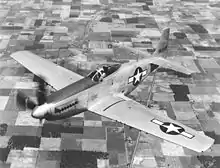 P-51H Mustang
P-51H Mustang - P-52 – Bell
- P-53 – Curtiss
- P-54 Swoose Goose – Vultee
- P-55 Ascender – Curtiss
- P-56 Black Bullet – Northrop
- P-57 Peashooter – Tucker
- P-58 Chain Lightning – Lockheed
- P-59 – Bell
- P-59 Airacomet – Bell (conflicting designation, assigned after the original P-59 was canceled)
- P-60 – Curtiss
- P-61 Black Widow – Northrop
- P-62 – Curtiss
- P-63 Kingcobra – Bell
- P-64 – North American
- P-65 – Grumman
- P-66 Vanguard – Vultee
- P-67 Bat – McDonnell
- P-68 Tornado – Vultee
- P-69 – Republic
- P-70 Nighthawk – Douglas
- P-71 – Curtiss
- P-72 – Republic
- P-73 – Hughes (unofficial designation created for contract purposes)
- P-74 – skipped
- P-75 Eagle – Fisher
- P-76 – Bell
- P-77 – Bell
- P-78 – North American (redesignated P-51B)
- P-79 – Northrop
- P-80 Shooting Star – Lockheed
- P-81 – Convair
- P-82 Twin Mustang – North American
- P-83 – Bell
- P-84 Thunderjet – Republic
- P-85 Goblin – McDonnell
- P-86 Sabre – North American
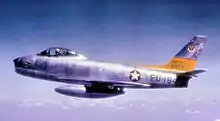 F-86F Sabre
F-86F Sabre - P-87 Blackhawk – Curtiss
- P-88 Voodoo – McDonnell
- P-89 Scorpion – Northrop
- P-90 – Lockheed
- P-91 Thunderceptor – Republic
- P-92 – Convair
Non-sequential
- P-322 Lightning – Lockheed (designation of rejected Royal Air Force Lightning Mk Is in USAAF service)
- P-400 Airacobra – Bell (designation of former RAF Airacobra Mk Is in USAAF service)
F: Fighter (1948–1962)
- F-38 Lightning – Lockheed (redesignated from P-38)
- F-39 Airacobra – Bell (redesignated from P-39)
- F-40 Warhawk – Curtiss (redesignated from P-40)
- F-47 Thunderbolt – Republic (redesignated from P-47)
- F-51 Mustang – North American (redesignated from P-51)
- F-61 Black Widow – Northrop (redesignated from P-61)
- RF-61C Reporter – Northrop (redesignated from F-15)
- F-63 Kingcobra – Bell (redesignated from P-63)
- F-80 Shooting Star – Lockheed (redesignated from P-80)
- F-81 – Convair (redesignated from P-81)
- F-82 Twin Mustang – North American (redesignated from P-82)
- F-83 – Bell (redesignated from P-83)
- F-84 Thunderjet – Republic (redesignated from P-84)
- F-84F Thunderstreak – Republic (redesignated from F-96)
- F-84H Thunderscreech – Republic
- F-85 Goblin – McDonnell (redesignated from P-85)
- F-86 Sabre – North American (redesignated from P-86)
- F-86C Sabre – North American (redesignated F-93)
- F-86D/G/K/L Sabre – North American (redesignated from F-95)
- F-87 Blackhawk – Curtiss (redesignated from P-87)
- F-88 Voodoo – McDonnell (redesignated from P-88)
- F-89 Scorpion – Northrop (redesignated from P-89)
- F-90 – Lockheed (redesignated from P-90)
- F-91 Thunderceptor – Republic (redesignated from P-91)
- F-92 – Convair (redesignated from P-92)
- F-93 – North American (redesignated from F-86C)
- F-94 Starfire – Lockheed
- F-95 – North American (redesignated F-86D)
- F-96 – Republic (redesignated F-84F)
- F-97 Starfire – Lockheed (redesignated F-94C)
- F-98 Falcon – Hughes
- F-99 BOMARC – Boeing
- F-100 Super Sabre – North American
- F-100B Super Sabre – North American (redesignated F-107)
- F-101 Voodoo – McDonnell
- F-102 Delta Dagger – Convair
- F-102B Delta Dagger – Convair (redesignated F-106)
- F-103 – Republic
- F-104 Starfighter – Lockheed
- XF-104 Starfighter – Lockheed
- NF-104A Starfighter – Lockheed
- F-105 Thunderchief – Republic
- F-106 Delta Dart – Convair (redesignated from F-102B)
- F-107 – North American (redesignated from F-100B)
- F-108 Rapier – North American
- F-109 – designation was reserved for the F-101B[7] and Bell D-188A, but never officially assigned
- F-110 Spectre – McDonnell Douglas
- F-111 Aardvark – General Dynamics
- F-111B Aardvark – General Dynamics/Grumman
- EF-111A Raven – General Dynamics/Grumman
- AFTI/F-111A Aardvark – General Dynamics/Boeing
 General Dynamics F-111
General Dynamics F-111
- Unofficial designations YF-112 and up were later assigned to black projects.
Non-sequential
- F-24 Banshee – Douglas (redesignated from A-24 in 1948)
FM: Fighter, Multiplace
- FM-1 Airacuda – Bell
- FM-2 – Lockheed (redesignated from PB-3)
PB: Pursuit, Biplace
- PB-1 – Berliner-Joyce (redesignated from P-16)
- PB-2 – Consolidated (redesignated from P-30)
- PB-3 – Lockheed (redesignated FM-2)
CG: Cargo Glider (1941–1948)
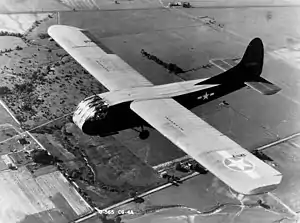
- CG-1 – Frankfort
- CG-2 – Frankfort
- CG-3 – Waco
- CG-4 Hadrian – Waco
- CG-5 – St. Louis
- CG-6 – St. Louis
- CG-7 – Bowlus
- CG-8 – Bowlus
- CG-9 – AGA Aviation
- CG-10 Trojan Horse – Laister-Kauffman
- CG-11 – Snead
- CG-12 – Read-York
- CG-13 – Waco
- CG-14 – Chase
- CG-15 Hadrian – Waco
- CG-16 – General Airborne Transport
- CG-17 – Douglas
- CG-18 – Chase
- CG-19 – Douglas
- CG-20 – Chase
FG: Fuel Glider (1930–1948)
- FG-1 – Cornelius
TG: Training Glider (1941–1948)
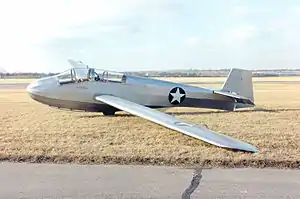
- TG-1 – Frankfort
- TG-2 – Schweizer
- TG-3 – Schweizer
- TG-4 – Laister-Kauffman
- TG-5 Grasshopper – Aeronca
- TG-6 Grasshopper – Taylorcraft
- TG-7 Orlik – Warsztaty Szybowcowe
- TG-8 Grasshopper – Piper
- TG-9 – Sailplane Corporation of America
- TG-10 – Wichita Engineering
- TG-11 – Schempp-Hirth
- TG-12 – Bowlus
- TG-13 – Sailplane Corporation of America
- TG-14 – Stiglmeier
- TG-15 – Franklin
- TG-16 – Schultz
- TG-17 – Franklin
- TG-18 – Midwest Sailplane
- TG-19 – DFS
- TG-20 – Schempp-Hirth
- TG-21 – Notre Dame
- TG-22 – Mehlhose
- TG-23 – Harper-Corcoran
- TG-24 – Schempp-Hirth
- TG-25 Plover – Wolcott
- TG-26 – Universal
- TG-27 – Schneider
- TG-28 Hawk Junior – Haller
- TG-29 – Volmer Jensen
- TG-30 Bluebird – Smith
- TG-31 – Aero Industries
- TG-32 – Pratt-Read
- TG-33 – Aeronca
G: Glider (1948–1955)
In 1948, all the glider categories were unified into a single sequence.
- G-2 – Ridgefield (redesignated from PG-2)
- G-3 – Waco (redesignated from PG-3)
- G-4 Hadrian – Waco (redesignated from CG-4)
- G-10 Trojan Horse – Laister-Kauffman (redesignated from CG-10)
- G-13 – Waco (redesignated from CG-13)
- G-14 – Chase (redesignated from CG-14)
- G-15 Hadrian – Waco (redesignated from CG-15)
- G-18 – Chase (redesignated from CG-18)
- G-20 – Chase (redesignated from CG-20)
S: Sailplane (1960–1962)
- S-1 – Schweizer
- S-2 – Schweizer
L: Liaison (1942–1962)
- L-1 Vigilant – Stinson (redesignated from O-49 in 1942)
- L-2 Grasshopper – Taylorcraft (redesignated from O-57 in 1942)
- L-3 Grasshopper – Aeronca (redesignated from O-58 in 1942)
- L-4 Grasshopper – Piper (redesignated from O-59 and C-83A in 1942)
- L-4F/G Grasshopper – Piper (redesignated from C-83 in 1942)
- L-5 Sentinel – Stinson (redesignated from O-62 in 1942)
- L-6 Grasshopper – Interstate (redesignated from O-63 in 1942)
- L-7 – Universal
- L-8 Cadet – Interstate
- L-9 – Stinson (redesignated from AT-19 in 1942)
- L-10 – Ryan
- L-11 – Bellanca
- L-12 Reliant – Stinson
- L-13 – Stinson/Convair
- L-14 Cub – Piper
- L-15 Scout – Boeing
- L-16 Champion – Aeronca
- L-17 Navion – North American/Ryan
- L-18 Super Cub – Piper
- L-19 Bird Dog – Cessna
- L-20 Beaver – de Havilland Canada
- L-21 Super Cub – Piper
- L-22 Navion – Ryan
- L-23 Seminole – Beechcraft
- L-24 Courier – Helio
- L-25 – McDonnell
- L-26 Commander – Aero Design
- L-27 – Cessna
- L-28 Super Courier – Helio
O: Observation (1924–1942)
- O-1 Falcon – Curtiss
- O-2 – Douglas
- O-3 Mohawk – Dayton-Wright
- O-4 – Martin
- O-5 – Douglas
- O-6 – Thomas-Morse
- O-7 – Douglas
- O-8 – Douglas
- O-9 – Douglas
- O-10 – Loening
- O-11 Falcon – Curtiss
- O-12 Falcon – Curtiss
- O-13 Falcon – Curtiss
- O-14 – Douglas
- O-15 – Keystone
- O-16 Falcon – Curtiss
- O-17 Courier – Consolidated
- O-18 Falcon – Curtiss
- O-19 – Thomas-Morse
- O-20 – Thomas-Morse
- O-21 – Thomas-Morse
- O-22 – Douglas
- O-23 – Thomas-Morse
- O-24 – Curtiss
- O-25 – Douglas
- O-26 – Curtiss
- O-27 – Fokker
- O-28 Corsair – Vought
- O-29 – Douglas
- O-30 – Curtiss
- O-31 – Douglas
- O-32 – Douglas
- O-33 – Thomas-Morse
- O-34 – Douglas
- O-35 – Douglas
- O-36 – Douglas
- O-37 – Keystone
- O-38 – Douglas
- O-39 Falcon – Curtiss
- O-40 Raven – Curtiss
- O-41 – Thomas-Morse
- O-42 – Thomas-Morse
- O-43 – Douglas
- O-44 – Douglas
- O-45 – Martin
- O-46 – Douglas
- O-47 – North American
- O-48 – Douglas
- O-49 Vigilant – Stinson
- O-50 – Bellanca
- O-51 Dragonfly – Ryan
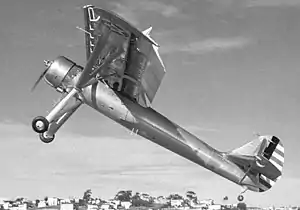 YO-51 Dragonfly
YO-51 Dragonfly - O-52 Owl – Curtiss
- O-53 Havoc – Douglas
- O-54 – Stinson
- O-55 – ERCO
- O-56 Ventura – Lockheed
- O-57 Grasshopper – Taylorcraft
- O-58 Grasshopper – Aeronca
- O-59 Grasshopper – Piper
- O-60 – Kellett
- O-61 – Pitcairn
- O-62 Sentinel – Stinson
- O-63 Grasshopper – Interstate
F: Photographic Reconnaissance (1930–1948)
- F-1 – Fairchild
- F-2 Expeditor – Beechcraft
- F-3 Havoc – Douglas
- F-4 Lightning – Lockheed
- F-5 Lightning – Lockheed
- F-6 Mustang – North American
- F-7 Liberator – Consolidated
- F-8 Mosquito – de Havilland
- F-9 Flying Fortress – Boeing
- F-10 Mitchell – North American
- F-11 – Hughes
- F-12 Rainbow – Republic
- F-13 Superfortress – Boeing
- F-14 Shooting Star – Lockheed
- F-15 Reporter – Northrop
R: Reconnaissance (1948–1962)
- R-11 – Hughes (redesignated from F-11)
- R-12 Rainbow – Republic (redesignated from F-12)
- R-16 Stratofortress – Boeing[8]
RS: Reconnaissance/Strike (1960–1962)
Both of the following aircraft are numbered in the B- (bomber) sequence.
R: Rotary wing (1941–1948)
In 1941, the category letter R- was allotted for "rotary wing" aircraft, and this designation was used until the founding of the United States Air Force in 1947, at which point the category letter was changed to H-, for "helicopter". However, the original numbering sequence was retained.
- R-1 – Platt-LePage
- R-2 – Kellett
- R-3 – Kellett
- R-4 Hoverfly – Sikorsky
- R-5 Dragonfly – Sikorsky
- R-6 Hoverfly II – Sikorsky
- R-7 – Sikorsky
- R-8 Kellett
- R-9 – Firestone
- R-10 – Kellett
- R-11 – Rotorcraft
- R-12 – Bell
- R-13 Sioux – Bell
- R-14 – Firestone
- R-15 – Bell
- R-16 – Piasecki
H: Helicopter (1948–1962)
- H-5 Dragonfly – Sikorsky (redesignated from R-5)
- H-6 Hoverfly II – Sikorsky (redesignated from R-6)
- H-9 – Firestone (redesignated from R-9)
- H-10 – Kellett (redesignated from R-10)
- H-11 – Rotorcraft (redesignated from R-11)
- H-12 – Bell (redesignated from R-12)
- H-13 Sioux – Bell (redesignated from R-13)
- H-14 – Firestone (redesignated from R-14)
- H-15 – Bell (redesignated from R-15)
- H-16 – Piasecki (redesignated from R-16)
- H-17 – Hughes/Kellett
- H-18 – Sikorsky
- H-19 Chickasaw – Sikorsky
- H-20 Little Henry – McDonnell
- H-21 Workhorse/Shawnee – Piasecki
- H-22 – Kaman
- H-23 Raven – Hiller
- H-24 – Seibel
- H-25 Army Mule – Piasecki
- H-26 Jet Jeep – American Helicopter
- H-27 Transporter – Piasecki
- H-28 – Hughes
- H-29 – McDonnell
- H-30 – McCulloch
- H-31 – Doman
- H-32 Hornet – Hiller
- H-33 – Bell
- H-34 Choctaw – Sikorsky
- H-35 – McDonnell (redesignated from L-25)
- H-36 – reserved for secret project LONG EARS
- H-37 Mojave – Sikorsky
- H-38 – reserved for secret project SHORT TAIL
- H-39 – Sikorsky
- H-40 – Bell
- H-41 Seneca – Cessna
- H-42 – Hughes
- H-43 Huskie – Kaman
- H-44 – reserved for secret project BIG TOM
- H-45 – reserved for secret project STEP CHILD
AT: Advanced Trainer (1925–1948)
- AT-1 – Huff-Daland
- AT-2 – Huff-Daland
- AT-3 – Boeing
- AT-4 Hawk – Curtiss
- AT-5 Hawk – Curtiss
- AT-6 Texan – North American
- AT-7 Navigator – Beechcraft
- AT-8 Bobcat – Cessna
- AT-9 Jeep – Curtiss-Wright
- AT-10 Wichita – Beechcraft
- AT-11 Kansan – Beechcraft
- AT-12 Guardsman – Republic
- AT-13 Gunner – Fairchild
- AT-14 Gunner – Fairchild
- AT-15 Crewmaker – Boeing
- AT-16 – Noorduyn
- AT-17 Bobcat – Cessna
- AT-18 Hudson – Lockheed
- AT-19 Reliant – Stinson
- AT-20 Anson – Federal
- AT-21 Gunner – Fairchild
- AT-22 Liberator – Consolidated
- AT-23 Marauder – Martin
- AT-24 Mitchell – North American
BC: Basic Combat (1936–1940)
- BC-1 – North American
- BC-2 – North American
- BC-3 – Vultee
BT: Basic Trainer (1930–1948)
- BT-1 – Douglas
- BT-2 – Douglas
- BT-3 – Stearman
- BT-4 – Curtiss
- BT-5 – Stearman
- BT-6 – Consolidated
- BT-7 – Consolidated
- BT-8 – Seversky
- BT-9 – North American
- BT-10 – North American
- BT-11 – Aircraft Research
- BT-12 – Fleetwings
- BT-13 Valiant – Vultee
- BT-14 – North American
- BT-15 Valiant – Vultee
- BT-16 Valiant – Vultee
- BT-17 – Boeing-Stearman
PT: Primary Trainer (1925–1948)
- PT-1 Trusty – Consolidated
- PT-2 Trusty – Consolidated
- PT-3 Trusty – Consolidated
- PT-4 Trusty – Consolidated
- PT-5 Trusty – Consolidated
- PT-6 – Consolidated
- PT-7 Pinto – Mohawk
- PT-8 – Consolidated
- PT-9 – Stearman
- PT-10 – Verville
- PT-11 – Consolidated
- PT-12 – Consolidated
- PT-13 Kaydet – Boeing-Stearman
- PT-14 – Waco
- PT-15 – St. Louis
- PT-16 – Ryan
- PT-17 Kaydet – Boeing-Stearman
- PT-18 Kaydet – Boeing-Stearman
- PT-19 Cornell – Fairchild
- PT-20 – Ryan
- PT-21 Recruit – Ryan
- PT-22 Recruit – Ryan
- PT-23 Cornell – Fairchild
- PT-24 Tiger Moth – de Havilland[9]
- PT-25 – Ryan
- PT-26 Cornell – Fairchild
- PT-27 Kaydet – Boeing-Stearman
T: Trainer (1948–1962)
In 1948, the Advanced, Basic, and Primary Trainer categories were unified into one sequence. Below are the designations that were assigned before the introduction of the Tri-Service system. For the designations in the same sequence that were assigned after 1962, see #Continued original sequence (1962–present).
- T-6 Texan – North American (redesignated from AT-6)
- T-7 Navigator – Beechcraft (redesignated from AT-7)
- T-11 Kansan – Beechcraft (redesignated from AT-11)
- T-13 Valiant – Vultee (redesignated from BT-13)
- T-13 Kaydet – Boeing-Stearman (conflicting designation, redesignated from PT-13)
- T-17 Kaydet – Boeing-Stearman (redesignated from PT-17)
- T-19 Cornell – Fairchild (redesignated from PT-19)
- T-28 Trojan – North American
- T-29 Samaritan – Convair
- T-30 – Douglas
- T-31 – Fairchild
- T-32 Samaritan – Convair
- T-33 Shooting Star – Lockheed
- T-34 Mentor – Beechcraft
- T-35 Buckaroo – Temco
- T-36 – Beechcraft
- T-37 Tweet – Cessna
- T-38 Talon – Northrop
- T-39 Sabreliner – North American
- T-40 JetStar – Lockheed
Army system (1956–1962)
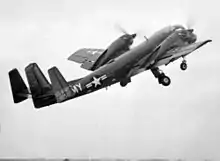
In 1956, the U.S. Army adopted a new, and relatively simple, designation system for its aviation assets. Aircraft were divided into three different types – 'A' for fixed-wing aircraft, 'H' for helicopters, or 'V' for V/STOL aircraft, and then were given a mission modifier, which, unlike the USAF system, came after the type code: 'C' for transports, 'O' for observation and reconnaissance aircraft, 'U' for utility types, and 'Z' for experimental aircraft. Aircraft types designated in this system were numbered sequentially.[10] For more information on the designation system, see 1956 United States Army aircraft designation system.
AC: Airplane, Cargo (1956–1962)
- AC-1 Caribou – de Havilland Canada (redesignated CV-2 in 1962, then C-7 in 1967)
- AC-2 Buffalo – de Havilland Canada (redesignated CV-7 in 1962, then C-8 in 1967)
AO: Airplane, Observation (1956–1962)
- AO-1 Mohawk – Grumman (redesignated OV-1 in 1962)
- AO-2 Inflatoplane – Goodyear
- AO-3 Inflatoplane – Goodyear
HO: Flying Platform (1956–1956)
- HO-1 Pawnee – Hiller (redesignated VZ-1 in 1956)
- HO-2 – de Lackner Helicopters (redesignated HZ-1 in 1956)
HC: Helicopter, Cargo (1956–1962)
- HC-1A Sea Knight (redesignated H-46 in 1962)
- HC-1B Chinook (redesignated H-47 in 1962)
HO: Helicopter, Observation (1956–1962)
HU: Helicopter, Utility (1956–1962)
- HU-1 Iroquois – Bell (redesignated H-1 in 1962)
HZ: Helicopter, Experimental (1956–1962)
- HZ-1 Aerocycle – de Lackner Helicopters
VZ: Vertical Takeoff and Landing Research (1956–1962)
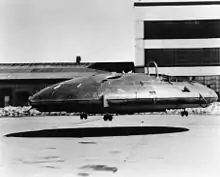
- VZ-1 Pawnee – Hiller
- VZ-2 – Vertol
- VZ-3 Vertiplane – Ryan
- VZ-4 Convertiplane – Doak
- VZ-5 Fledgling – Fairchild
- VZ-6 – Chrysler
- VZ-7 – Curtiss-Wright
- VZ-8 Airgeep – Piasecki
- VZ-9 Avrocar – Avro Canada
- VZ-10 Hummingbird – Lockheed (redesignated V-4 in 1962)
- VZ-11 Vertifan – Ryan (redesignated as V-5 in 1962)
- VZ-12 Kestrel – Hawker Siddeley (redesignated as V-6 in 1962)
Tri-Service system (1962–present)
For more information on the designation system, see 1962 United States Tri-Service aircraft designation system.
A: Attack aircraft
- A-1 Skyraider – Douglas (redesignated from Navy AD)
- A-2 Savage – North American (redesignated from Navy AJ)
- A-3 Skywarrior – Douglas (redesignated from Navy A3D)
- A-4 Skyhawk – Douglas (redesignated from Navy A4D)
- A-5 Vigilante – North American (redesignated from Navy A3J)
- A-6 Intruder – Grumman (redesignated from Navy A2F)
- A-7 Corsair II – Ling-Temco-Vought
- A-8 – skipped
- A-9 – Northrop
- A-10 Thunderbolt II – Fairchild Republic
- A-11 – skipped
- A-12 Avenger II – McDonnell Douglas/General Dynamics
Non-sequential designations
- F/A-18 Hornet – McDonnell Douglas[11]
- F/A-18E/F Super Hornet – Boeing[11]
- EA-18G Growler – Boeing
- A-26 Invader – Douglas (originally designated A-26, then B-26 after the B-26 Marauder was retired, reverted to original A-26 in Vietnam era)
- A-29 Super Tucano – Embraer
- A-37 Dragonfly – Cessna (redesignated from AT-37)
B: Bomber
Non-sequential designation
- B-21 Raider – Northrop Grumman
- FB-22 – Lockheed Martin
- FB-111 Aardvark – General Dynamics (redesignated F-111G after role change)
C: Transport
- C-1 Trader – Grumman (redesignated from Navy TF)
- C-2 Greyhound – Grumman
- C-3 – Martin (redesignated from Navy RM)
- C-4 Academe – Gulfstream
- C-5 Galaxy – Lockheed
- C-6 – Beechcraft
- C-7 Caribou – de Havilland Canada
- C-8 Buffalo – de Havilland Canada
- C-9 Nightingale/Skytrain II – McDonnell Douglas
- C-10 Jetstream – Handley Page
- C-10 Extender – McDonnell Douglas (conflicting designation, assigned after original C-10 was canceled)
- C-11 – Gulfstream
- C-12 Huron – Beechcraft
- RC-12 Guardrail – Beechcraft
- C-13 – skipped
- C-14 – Boeing
- C-15 – McDonnell Douglas
- C-16 – skipped
- C-17 Globemaster III – Boeing
- C-18 – Boeing
- C-19 – Boeing
- C-20 – Gulfstream
- C-20F/G/H/J – Gulfstream
- C-21 – Learjet
- C-22 – Boeing
- C-23 Sherpa – Short
- C-24 – Douglas
- C-25 – Boeing
- C-26 – Fairchild
- C-27 Spartan – Aeritalia
- C-28 Titan – Cessna
- C-29 – British Aerospace
- C-30 – skipped
- C-31 Troopship – Fokker
- C-32 – Boeing
- C-33 – Boeing
- C-34 – skipped
- C-35 – Cessna
- C-36 – skipped
- C-37 – Gulfstream
- C-38 – Gulfstream
- C-39 – skipped
- C-40 Clipper – Boeing
- C-41 – CASA[12]
- C-42 – skipped
- C-43 – skipped
- C-44 – skipped
- C-45 – EADS/Northrop Grumman[12]
- C-46 Pegasus – Boeing
Revived 1924-1962 sequence (2005-present)
D: Unmanned aerial vehicle (UAV) control segment
The "D" sequence is assigned to ground control stations for UAVs.
- D-1 – General Atomics, ground equipment for the MQ-1 Predator
- D-2 – Northrop Grumman, ground equipment for the RQ-4 Global Hawk
E: Special electronic installation
- E-1 Tracer – Grumman (redesignated from Navy WF)
- E-2 Hawkeye – Grumman (redesignated from Navy W2F)
- E-3 Sentry – Boeing
- E-4 – Boeing
- E-5 Eagle – Windecker
- E-6 Mercury – Boeing
- E-7 – designation proposed for EC-18B but not approved
- E-8 Joint STARS – Northrop Grumman
- E-9 Widget – de Havilland Canada
- E-10 MC2A – Boeing/Northrop Grumman
- E-11 – Bombardier/Northrop Grumman
F: Fighter
- F-1 Fury – North American (redesignated from Navy FJ)
- F-1E/F Fury – North American (redesignated from Navy FJ-4)
- F-2 Banshee – McDonnell (redesignated from Navy F2H)
- F-3 Demon – McDonnell (redesignated from Navy F3H)
- F-4 Phantom II – McDonnell Douglas (redesignated from Navy F4H and Air Force F-110)
- F-5 Freedom Fighter/Tiger II – Northrop
- F-5G – Northrop (redesignated to F-20)
- F-6 Skyray – Douglas (redesignated from Navy F4D)
- F-7 Sea Dart – Convair (redesignated from Navy F2Y)
- F-8 Crusader – Vought (redesignated from Navy F8U)
- F-9 Panther – Grumman (redesignated from Navy F9F)
- F-9F/H/J Cougar – Grumman (redesignated from Navy F9F-6/7/8)
- F-10 Skyknight – Douglas (redesignated from Navy F3D)
- F-11 Tiger – Grumman (redesignated from Navy F11F)
- F-12 – Lockheed
- F-12C – Lockheed (unofficial cover designation for the SR-71)
- F-13 – skipped
- F-14 Tomcat – Grumman
- F-15 Eagle – McDonnell Douglas
- F-15E Strike Eagle – McDonnell Douglas/Boeing
- F-16 Fighting Falcon – General Dynamics/Lockheed Martin
- NF-16D VISTA – General Dynamics/Lockheed Martin (redesignated X-62 in 2021)
- F-16XL – General Dynamics
- F-17 Cobra – Northrop
- F/A-18 Hornet – McDonnell Douglas
- F/A-18E/F Super Hornet – Boeing
- EA-18G Growler – Boeing
- F-19 – skipped
- F-20 Tigershark – Northrop (redesignated from F-5G)
- F-21 Kfir – Israel Aerospace Industries
- F-22 Raptor – Lockheed Martin
- F-23 Black Widow II – Northrop/McDonnell Douglas
Non-sequential designations
Other designations
Designations YF-110, YF-112 through YF-116, and YF-118 were captured foreign aircraft used for evaluation and aggressor training. They were given designations in sequence—based on chronology—with black project aircraft, continuing the pre-1962 "F" series.[14][15]
G: Glider
- G-1 – Schweizer
- G-2 – Schweizer
- G-3 – Schweizer[17]
- G-4 – Schweizer[17]
- G-5 – Schweizer
- G-6 – Schweizer
- G-7 – Schweizer[17]
- G-8 – Schweizer
- G-9 – Schleicher[17]
- G-10 – Let[18][17]
- G-11 – Stemme[17]
- G-12 – Caproni Vizzola[18]
- G-13 – skipped
- G-14 – Aeromot[18]
- G-15 – Schempp-Hirth[18]
- G-15B – Schempp-Hirth
- G-16 – DG Flugzeugbau
H: Helicopter
Unlike most other categories of aircraft, the introduction of the tri-service designation system in 1962 did not result in a wholesale redesignation of helicopters. While six types received new designations in the unified, "re-started" sequence, the original "H-" series of designations that started in 1948 was also continued, and no further types of rotorcraft have been designated in the "post-1962" system.
- H-1 – Bell
- UH-1 Iroquois – Bell (redesignated from Army HU-1 and Air Force H-40, UH-1F redesignated from H-48)
- UH-1N Twin Huey – Bell
- UH-1Y Venom – Bell
- AH-1 Cobra – Bell
- AH-1J/T/W SeaCobra/SuperCobra – Bell
- AH-1Z Viper – Bell
- UH-1 Iroquois – Bell (redesignated from Army HU-1 and Air Force H-40, UH-1F redesignated from H-48)
- H-2 Seasprite – Kaman (redesignated from Navy HU2K)
- H-2G Super Seasprite – Kaman
- H-3 Sea King – Sikorsky (redesignated from Navy HSS-2)
- H-3C/E/F Sea King – Sikorsky
- H-4 – Bell (redesignated from Army HO-4)
- H-5 – Fairchild Hiller (redesignated from Army HO-5)
- H-6 Cayuse – Hughes/ McDonnell Douglas/MD Helicopters (redesignated from Army HO-6)
- AH-6 Little Bird – Boeing
- MH-6 Little Bird – Hughes/ McDonnell Douglas/MD Helicopters
Continuation of 1948 sequence
- H-46 Sea Knight – Boeing Vertol
- H-47 Chinook – Boeing Vertol
- H-48 – Bell (redesignated UH-1F)
- H-49 – Boeing Vertol (redesignated H-46B)
- H-50 DASH – Gyrodyne
%252C_circa_in_1963_(4561400925).jpg.webp)
- H-51 – Lockheed
- H-52 Sea Guard – Sikorsky
- H-53 Sea Stallion – Sikorsky
- MH-53 Pave Low – Sikorsky
- CH-53E Super Stallion – Sikorsky
- CH-53K King Stallion – Sikorsky[19]
- H-54 Tarhe – Sikorsky
- H-55 Osage – Hughes
- H-56 Cheyenne – Lockheed
- H-57 Sea Ranger – Bell
- H-58 Kiowa – Bell
- H-59 – Sikorsky
- H-60 Black Hawk – Sikorsky
- Sikorsky SH-60 Seahawk – Sikorsky
- Sikorsky HH-60 Pave Hawk – Sikorsky
- Sikorsky MH-60 Jayhawk – Sikorsky
- H-61 – Boeing Vertol
- H-62 – Boeing Vertol
- H-63 Kingcobra – Bell
- H-64 Apache – Hughes
- H-65 Dolphin – Aérospatiale
- H-66 Comanche – Boeing/Sikorsky
- H-67 Creek – Bell
- H-68 Stingray – Agusta[19]
- H-69 – skipped
- H-70 Arapaho – Bell[19]
- H-71 Kestrel – Lockheed Martin[19]
- H-72 Lakota – Eurocopter[19]
- H-73 Koala – AgustaWestland
Non-sequential designations
- H-90 Enforcer – MD Helicopters
- H-92 – Sikorsky
- VH-92 – Sikorsky
- H-139 Grey Wolf – AgustaWestland
K: Tanker (modified mission designator)
No specialised types have been acquired to receive a stand-alone 'K for Tanker' designation; for aircraft modified for use as tankers, see the parent aircraft in the proper sequence.
O: Observation
- O-1 Bird Dog – Cessna (redesignated from Air Force L-19)
- O-2 Skymaster – Cessna
- O-3 Quiet Star – Lockheed
- O-4 – Wren
- O-5 ARL – de Havilland Canada
- O-6 – de Havilland Canada
P: Maritime patrol
- P-1 – skipped
- P-2 Neptune – Lockheed (redesignated from Navy P2V)
- P-3 Orion – Lockheed (redesignated from Navy P3V)
- EP-3 Orion/ARIES – Lockheed
- WP-3D Orion – Lockheed
- P-4 Privateer – Consolidated (redesignated from Navy PB4Y-2/P4Y-2)
- P-5 Marlin – Martin (redesignated from Navy P5M)
- P-6 – skipped
- P-7 – Lockheed
- P-8 Poseidon – Boeing
- P-9 – McDonnell Douglas
Q: Unmanned Aerial Vehicle (UAV)
- Q-1 Predator – General Atomics
- Q-1C Gray Eagle – General Atomics
- Q-2 Pioneer – AAI/Israel Aerospace Industries
- Q-3 Dark Star – Lockheed Martin/Boeing
- Q-4 Global Hawk – Northrop Grumman
- Q-4C Triton – Northrop Grumman
- Q-5 Hunter – Israel Aerospace Industries
- Q-6 Outrider – Alliant
- Q-7 Shadow – AAI
- Q-8 Fire Scout – Northrop Grumman
- Q-8C Fire Scout – Northrop Grumman
- Q-9 Reaper – General Atomics
- Q-10 SnowGoose – MMIST
- Q-11 Raven – AeroVironment
- Q-12 – AeroVironment
- Q-13 – skipped
- Q-14 Dragon Eye – AeroVironment
- Q-15 Neptune – DRS
- Q-16 T-Hawk – Honeywell
- Q-17 SpyHawk – MTC Technologies
- Q-18 Hummingbird – Boeing
- Q-19 Aerosonde – AAI[21]
- Q-20 Puma – AeroVironment
- Q-20 Avenger – General Atomics (conflicting designation)
- Q-21 Integrator – Boeing Insitu
- Q-22 – AeroVironment
- Q-23 – NASC
- Q-24 – Kaman
- Q-25 Stingray – Boeing
- Q-26 – skipped
- Q-27 – Boeing
Non-sequential designations
- Q-58 – Kratos
- Q-72 Great Horned Owl – Northrop Grumman
- Q-170 Sentinel – Lockheed Martin
- Q-180 – Northrop Grumman
S: Anti-submarine warfare
- S-1 – skipped
- S-2 Tracker – Grumman (redesignated from Navy S2F)
- S-3 Viking/Shadow – Lockheed
SR: Strategic Reconnaissance
The "SR" sequence is a continuation of the original USAF bomber sequence, which ended at B-70.
T: Trainer
Despite the adoption of the unified Mission Designation System in 1962, only two aircraft were designated in the new sequence, both former Navy types. New trainer aircraft after 1962 continued to use the original sequence. In 1990, an alternate sequence was started, with the first designation being T-1, though the old sequence continues to be used. The next designation available in the 'T' series is T-54 or T-8, depending on which series is continued.
Continued original sequence (1962–present)
Only aircraft designated after the adoption of the Tri-Service system are listed below. For aircraft in the sequence designated before 1962, see #T: Trainer (1948–1962).
- T-41 Mescalero – Cessna
- T-42 Cochise – Beechcraft
- T-43 – Boeing
- T-44 Pegasus – Beechcraft
- T-45 Goshawk – McDonnell Douglas/BAE Systems
- T-46 – Fairchild
- T-47 – Cessna
- T-48 – Cessna
- T-48 MPATS – unknown contractor[22] (conflicting designation, assigned after the original T-48 was canceled)
- T-49 – Boeing[22]
- T-50 Golden Eagle – Korea Aerospace Industries (designation reserved, none procured)[22]
- T-51 – Cessna[22]
- T-52 – Diamond[23]
- T-53 – Cirrus
1962 redesignations
- T-1 SeaStar – Lockheed (redesignated from Navy T2V)
- T-2 Buckeye – North American (redesignated from Navy T2J)
1990 Sequence
- T-1 Jayhawk – Raytheon/Hawker Beechcraft
- T-2 – skipped (T-2 Buckeye was still in service)
- T-3 Firefly – Slingsby
- T-4 – skipped
- T-5 – skipped
- T-6 Texan II – Hawker Beechcraft
- T-7 Red Hawk – Boeing
U: Utility
- U-1 Otter – de Havilland Canada
- U-2 – Lockheed (cover designation to hide the aircraft's true role)
- U-3 – Cessna (redesignated from Air Force L-27)
- U-4 – Aero Commander (redesignated from Air Force L-26)
- U-5 Twin Courier – Helio
- U-6 Beaver – de Havilland Canada (redesignated from Army L-20)
- U-7 Super Cub – Piper (redesignated from Army L-21)
- U-8 Seminole – Beechcraft (redesignated from Army L-23)
- U-9 – Aero Commander (redesignated from Army L-26)
- U-10 Super Courier – Helio (redesignated from Army L-28)
- U-11 Aztec – Piper (redesignated from Navy UO)
- U-12 – skipped
- U-13 – skipped
- U-14 – skipped
- U-15 – skipped
- U-16 Albatross – Grumman (redesignated from Air Force A-16 and Navy UF)
- U-17 Skywagon – Cessna
- U-18 Navion – North American/Ryan (redesignated from Army L-17)
- U-19 Sentinel – Stinson (redesignated from Army L-5)
- U-20 – Cessna (redesignated from Air Force C-126)
- U-21 Ute – Beechcraft
- U-22 Pave Eagle – Beechcraft
- U-23 Peacemaker – Fairchild Hiller/Pilatus
- U-24 Stallion – Helio
- U-25 Guardian – Dassault
- U-26 Super Skywagon – Cessna
- U-27 Caravan – Cessna
- U-28 – Pilatus[24]
Non-sequential designations
V: Vertical take-off/short take-off and landing (VTOL/STOL)
- V-1 – Grumman (redesignated from Army AO-1)
- V-2 – de Havilland Canada (redesignated from Army AC-1)
- V-3 – Bell (redesignated from Air Force H-33)
- V-4 Hummingbird – Lockheed (redesignated from Army VZ-10)
- V-5 Vertifan – Ryan (redesignated from Army VZ-11)
- V-6 Kestrel – Hawker Siddeley (redesignated from Army VZ-12)
- V-7 Buffalo – de Havilland Canada (redesignated from Army AC-2)
- V-8 – Ryan
- V-8 Harrier – Hawker Siddeley (conflicting designation, assigned after original V-8 was retired)
- V-9 – Hughes
- V-10 Bronco – Rockwell/Boeing
- V-11 Marvel – Parsons
- V-12 – Parsons
- V-12 – Rockwell (conflicting designation, assigned after original V-12 was canceled)
- V-13 – skipped
- V-14 – skipped to avoid confusion with X-14[25]
- V-15 – Bell
- V-16 Harrier – McDonnell Douglas/British Aerospace (unofficial)
- V-17 – assigned to a U.S. Army project but not used[25]
- V-18 Twin Otter – de Havilland Canada
- V-19 – assigned to a U.S. Navy project but canceled[25]
- V-20 Chiricahua – Pilatus
- V-21 – rumored designation of an Airship Industries project[25]
- V-22 Osprey – Bell/Boeing
- V-23 Scout – Dominion
- V-24 LightningStrike – Aurora
X: Special research
In addition to aircraft intended to support military operations, the unified system includes experimental craft designed to push the boundaries of aeronautical and aerospace knowledge. These aircraft are designated in the "X-series", which led them to become known as "X-planes". Only those designated after 1962 are listed here. Some aircraft did not have military sponsors, but since they were designated under the same sequence they are listed here. For aircraft in the sequence designated before 1962, see #X: Experimental (1948–1962).
- X-21 – Northrop
- X-22 – Bell
- X-23 PRIME – Martin Marietta (unofficial)[26]
- X-24 – Martin Marietta
- X-25 – Bensen
- X-26 Frigate – Schweizer
- X-27 – Lockheed
- X-28 – Osprey
- X-29 – Grumman
- X-30 – Rockwell
- X-31 – Rockwell/MBB
- X-32 – Boeing
- X-33 – Lockheed Martin
- X-34 – Orbital
- X-35 – Lockheed Martin
- X-36 – McDonnell Douglas
- X-37 – Boeing
- X-38 – NASA/Scaled Composites
- X-39 – unknown contractor (unofficial)[26]
- X-40 – Boeing
- X-41 – unknown contractor
- X-42 – unknown contractor
- X-43 – NASA
- X-44 MANTA – Lockheed Martin
- X-44 – Lockheed Martin (conflicting designation)
- X-45 – Boeing
- X-46 – Boeing
- X-47 Pegasus – Northrop Grumman
- X-48 – Boeing
- X-49 SpeedHawk – Piasecki
- X-50 Dragonfly – Boeing
- X-51 Waverider – Boeing
- X-52 – skipped
- X-53 – Boeing
- X-54 – Gulfstream
- X-55 – Lockheed Martin
- X-56 – Lockheed Martin
- X-57 Maxwell – NASA
- X-58 – skipped
- X-59 QueSST – Lockheed Martin
- X-60 – Generation
- X-61 Gremlins – Dynetics
- X-62 VISTA – General Dynamics (redesignated from NF-16D in 2021)
Z: Lighter-than-air
- Z-1 – Goodyear[27]
- Z-2 Sentinel – Westinghouse/Airship Industries
- Z-3 – American Blimp[28]
- Z-4 – Hybrid Air Vehicles
Gallery of the progression of American fighters
.jpg.webp) French SPAD XIII fighter used in relatively large numbers by Aviation Section, U.S. Signal Corps in last year of World War I.
French SPAD XIII fighter used in relatively large numbers by Aviation Section, U.S. Signal Corps in last year of World War I. Curtiss P-1 Hawk. The Curtiss Hawk family formed the majority of US fighters in the interwar period. The final iteration the Curtiss P-40 Warhawk would be one of the two the main USAAF fighters in the middle years of World War II(1942-1943) alongside the Bell P-39 Airacobra.
Curtiss P-1 Hawk. The Curtiss Hawk family formed the majority of US fighters in the interwar period. The final iteration the Curtiss P-40 Warhawk would be one of the two the main USAAF fighters in the middle years of World War II(1942-1943) alongside the Bell P-39 Airacobra. North American P-51 Mustang most famous US aircraft of World War II and main late war fighter.
North American P-51 Mustang most famous US aircraft of World War II and main late war fighter.
 General Dynamics F-16 Fighting Falcon current main United States Air Force fighter as of 2022.
General Dynamics F-16 Fighting Falcon current main United States Air Force fighter as of 2022.
Gallery of the progression of American naval fighters
.jpg.webp) Grumman FF Naval fighter built in relatively large numbers and used on US carriers during the Interwar period.
Grumman FF Naval fighter built in relatively large numbers and used on US carriers during the Interwar period.%252C_in_1944.jpg.webp) Grumman F6F Hellcat which was main US naval fighter in late World War II.Succedded the similarly named Grumman F4F Wildcat. Despite the Vought F4U Corsair being available around the same time and being more famous it saw less use till the end of the war due to carrier landing problems.
Grumman F6F Hellcat which was main US naval fighter in late World War II.Succedded the similarly named Grumman F4F Wildcat. Despite the Vought F4U Corsair being available around the same time and being more famous it saw less use till the end of the war due to carrier landing problems..jpg.webp) Grumman F-14 Tomcat main US navy fighter from 1974 to 2000's. Replaced naval variant of McDonnell Douglas F-4 Phantom II. Famously starred in the movie Top Gun.
Grumman F-14 Tomcat main US navy fighter from 1974 to 2000's. Replaced naval variant of McDonnell Douglas F-4 Phantom II. Famously starred in the movie Top Gun..jpg.webp) Boeing F/A-18E/F Super Hornet current main US Navy fighter as of 2022. Serves alongside F-35C on US carriers.
Boeing F/A-18E/F Super Hornet current main US Navy fighter as of 2022. Serves alongside F-35C on US carriers.
See also
- F/A-XX program
- List of U.S. DoD aircraft designations
- United States military aircraft serial numbers
- List of active United States military aircraft
- List of undesignated military aircraft of the United States
- List of United States Navy aircraft designations (pre-1962)
- United States military aircraft engine designations
- List of fighter aircraft
- List of maritime patrol aircraft
- List of airborne early warning aircraft
- List of tanker aircraft
- United States unified missile designation sequence
References
Citations
- Trapp, Robert E.; Berkeley, William P.; Egerland, Arnold V. (1967). "The Criteria for an Equipment Identification Coding System" (PDF). Air Force Institute of Technology School of Systems and Logistics. p. III-20. Archived from the original (PDF) on 13 April 2022. Retrieved 13 April 2022.
- "Airship AC-1 Lands At Field". The Airship Log. Vol. 1. Belleville, Illinois: Meyer & Farrell. 4 May 1923. p. 1 – via Newspapers.com.
- "RN-1 Zodiac Arrived at Scott Field". The Airship Log. Vol. 1, no. 1. Belleville, Illinois: Meyer & Farrell. 4 May 1923. p. 1 – via Newspapers.com.
- "Lockheed B-71 (SR-71)". National Museum of the United States Air Force. October 29, 2009. Archived from the original on October 4, 2013. Retrieved 2013-10-02.
- Andrade 1979, page 60
- Knaack, Marcelle Size (1978). Encyclopedia of US Air Force Aircraft and Missile Systems: Volume 1 (PDF). Washington, D.C.: Office of Air Force History. p. 1. Retrieved 10 December 2020.
- "HazeGray.org". rec.aviation.military FAQ, Part 4. Retrieved 2007-01-13.
- Andrade 1979, p. 162
- Office of History, Headquarters Third Air Force, United States Air Forces in Europe: Installations and USAAF Combat Units in the United Kingdom 1942–1945, Revised and Expanded Edition Archived 2011-09-24 at the Wayback Machine. October 1980; reprinted February 1985
- Chorney, Andrew. Systems of Designation, U.S. Army Aircraft, 1956–1962 System. U.S. Military Aircraft Designations 1911–2004
- Officially, the F/A-18 is designated in both the A-for-attack and F-for-fighter series.
- Parsch 2009, "DOD 4120.15-L"
- Chorney, Andrew. "U.S. Military Aircraft Designations 1911-2004". www.driko.org.
- Parsch, Andreas (2006-11-27). "Cover Designations for Classified USAF Aircraft". Designation-Systems.Net. Retrieved 2006-12-29.
- Fulghum, David A., "MiGs in Nevada", Aviation Week & Space Technology, November 27, 2006
- "Edwards AFB website". Col. Joseph A. Lanni, USAF biography. Archived from the original on 2005-03-18. Retrieved 2007-01-07.
- "94th Flying Training Squadron aircraft". Archived from the original on 2009-03-10.
- Parsch 2009, "DOD 4120.15-L"
- Parsch 2009, "DOD 4120.15-L"
- DOD 4120.15-L: Model Designation of Military Aerospace Vehicles Archived 2007-10-25 at the Wayback Machine, Department of Defense, Office of the Undersecretary of Defense (AT&L) (Defense Systems), May 12, 2004. Retrieved April 7, 2010.
- Parsch 2009, "DOD 4120.15-L"
- Parsch 2009, "DOD 4120.15-L"
- "Photo essay: Flight of a T-52A" U.S. Air Force.
- Parsch 2009, "DOD 4120.15-L"
- Parsch, Andreas. ""Missing" USAF/DOD Aircraft Designations". Designation-Systems.Net. Retrieved 2010-04-13.
- Parsch 2009, "Missing Designations"
- DOD 4120.15-L: Model Designation of Military Aerospace Vehicles Archived 2007-10-25 at the Wayback Machine, Department of Defense, Office of the Undersecretary of Defense (AT&L) (Defense Systems), May 12, 2004. Retrieved April 7, 2010.
- Parsch 2009, "DOD 4120.15-L"
Sources
- Books
- Andrade, John M. (1979). U.S. Military Aircraft Designations and Serials Since 1909. Midland Counties Publications. ISBN 978-0-904597-22-6.
- Fahey, James C. (1946). U.S. Army Aircraft 1908–1946.
- Michael J.H. Taylor, ed. (1991). Jane's American Fighting Aircraft of the 20th Century. New York, NY: Mallard Press. ISBN 978-0-7924-5627-8.
